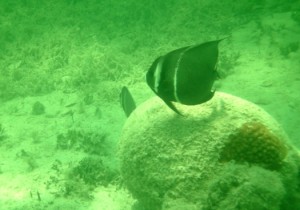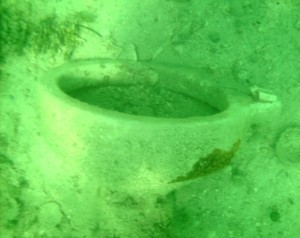We’re currently under the impression that we’ll be able to shove off tomorrow (Wednesday). Here’s how the saga of the shaft alignment problem has gone over the last week or so:
Friday (4/10): Found that there was an alignment problem that was likely a bent shaft.
Monday (4/13): Mechanic confirmed that there was an issue aft of the engine/transmission so we hauled the boat out, dropped the rudder, pulled the shaft, and took it to the mechanic to take to the machine shop.
Tuesday (4/14): The mechanic brought the machined shaft & coupling by on his way home from work, but we’d already found an issue with some glass work on the starboard keel, so we wouldn’t be ready to splash until Thursday.
Thursday (4/16): We re-installed the shaft and could have gotten back in the water, but the travel-lift at the yard broke and parts wouldn’t be available until Friday morning.
Friday (4/17): Splashed the boat around noon and called the marina where the mechanic has his shop, but they didn’t have a place for us to tie up; we have to wait through the weekend.
Monday (4/20): The marina still didn’t have a free spot to tie up, so we had to wait until Tuesday.
Tuesday (4/21): A spot on the fuel dock finally opened up and we were there before noon. The mechanic came by, but wasn’t able to align the shaft to the engine. At this point, they suspect the issue is the metal spacer between the shaft coupling and the engine transmission as the mounts seem to be OK and the shaft aligns properly to the transmission without it present. We’ll replace it with a drive-line saver, a sacrificial nylon spacer that isn’t as demanding in terms of alignment and will protect the transmission from damage in the event we get the prop shaft fouled with a line in the water. Unfortunately, the drive-line saver is damaging to the wallet and the mechanic/dealer didn’t have one in stock. It should be here by 10am tomorrow and if things work with it installed, we’ll be ready to go. If things don’t work, we’re going to be in for some more time in sunny Key West.
Since we’re tied up at the fuel dock, we’ve spent the day filling water and fuel tanks & jugs, spraying down the boat, making final repairs, defrosting the fridge/freezer and reducing its space to conserve DC, and stowing gear in preparation for our passage south. This is our first real diesel fill-up so we aren’t sure exactly how we’re doing on fuel economy, but it’s looking like about half a gallon an hour, which is about what we expected. With 50 gallons in each fuel tank and several jerry jugs, we should be able to motor quite a ways if needed, especially if we conserve fuel by running only one engine at a time.
Pura Vida has quite a bit of storage area, including lots of space in the bows. We’d tried to use the bows to stow only light items, but in spite of our attempts, the bows were a little low on their waterlines. Also, they seemed to bury too easily when heading into the waves close-hauled, and we were pitching or hobby-horsing more than we’d expected. Because we’re living in the forward cabins, we moved most of the stuff in the bows back into the aft cabins. The bows are definitely riding higher now and we’re hoping we’ll have a more sea-kindly motion as a result.
We have to give a shout-out to several of our friends who’ve provided hard drives with more music than we can possibly listen to. It has come in very handy. Our favorite approach is to copy songs onto a Flash drive and then use the flash drive in our stereo. My friend Kopan also sent us a hard drive of movies, which has made for great entertainment in the evenings while we’re at anchor waiting for repairs to be completed here in Key West.
Speaking of generous gifts, here are a couple of pictures from the underwater camera that we got as a gift at our wedding shower. The wind died down a little yesterday, which made things warmer on the boat and improved the visibility in the water where we’re anchored. Lauren took advantage of the clearer water to take a break from the heat and do some snorkeling around the boat. We wanted to get an anchor pic, but the Rocna completely buried itself in the sand. She did see a few fish and a discarded marine head.
For those of you keeping up with the various equipment issues, here’s a brief update. The autopilot did really well from Boca Raton down to Key West, including doing a good job of “auto-learning” our boat characteristics while headed into 3-4 foot seas. The one exception was that when sailing downwind, the autopilot couldn’t correctly keep track of the rudder orientation. It would eventually accumulate so much error in the assumed rudder position that it believed the rudder was hard over even though it wasn’t and would stop trying to turn the rudder anymore. It was easy enough to reset the autopilot, but annoying to keep an eye on it, so we installed the “optional” rudder reference and that should finish up the autopilot for the most part.
The problems with the electric starboard head (that’s the dumper, Casey & congrats on your engagement) turned out to be an old joker valve on the discharge. We replaced the joker valve and the bowl no longer back-fills. The somewhat weak discharge pump seems to have been partly due to the semi-clogged discharge elbow that houses the joker valve. It’s up and running like a champ, which has made things a little more pleasant in the port hull.
We haven’t had the battery capacity we’d expected after replacing the house batteries in Ft. Pierce. In fact, we’d had about half the expected capacity. We checked the battery connections, water levels, etc. and found that I’d missed tightening up the nut on one connection, so we’re now expecting to double our battery capacity. We have four Deka GC15’s, which should give us about 430 Ah (due to charge/discharge characteristics, it’s only reasonable to use about a third of the capacity, but we still should be able to go at least a couple days with little battery charging). We haven’t done too badly, even without all our battery capacity, as we so far haven’t had to run the engines just to charge the batteries. We’ve either had plenty of wind for the wind generators stopped at a marina, or had to run the engines anyway to get in or out of an anchorage.
Yesterday I installed the ICOM AIS receiver that had been back-ordered. We’ve hung around long enough that it finally came in, and Dad was able to send it to us. We’d purchased a radar, but the radome didn’t fit due to the jumpers on the forward portion of our mast. Because we’re not planning to sail in areas where fog is a frequent problem, we sold the radome and elected to get an AIS instead. AIS transmitters are mandatory on all large international ships, and we’re planning to use our receiver like a poor man’s radar. The AIS uses VHF frequencies to broadcast a vessel’s name, location, speed, heading, destination, etc. and is used primarily for collision avoidance. When you’re sailing near or crossing shipping lanes, especially at night, it can be difficult to tell exactly how far away a ship is or what its course may be. The AIS should be pretty handy in helping us identify and avoid shipping traffic, as all vessels with AIS transmitters now show up as targets on our chart-plotter.
We’ve made numerous other small repairs on a daily basis, and it does seem like we’re making a bit of progress in terms of functionality on the boat as well as settling into boat life.



